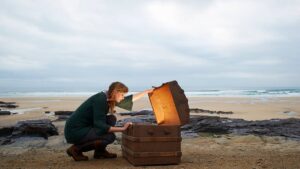Thick smoke billowing from Nimy’s nickel-copper project explains exceptional share price performance

Pic: Mathias Genterczewsky / EyeEm / Via Getty Images
There is smoke billowing everywhere from Nimy Resources’ (NIM) Mons nickel-copper project in WA, fuelling growing interest in the signal it is sending about the metal which lies below.
Located at the northern end of the rich Forrestania nickel belt, the early holes at Mons have confirmed the presence of a large mineralised system containing nickel and copper.
With only a few holes under its belt, it remains unclear exactly what Nimy has stumbled across. But the evidence to date suggests it hosts multiple mineralisation styles and extends to the surface.
Nimy recently completed its fourth diamond drill hole at Mons and results are expected any day. Meanwhile, the fifth hole is well underway.
The increasing fascination with what may unfold at Mons has resulted in Nimy shares currently trading at well over double their listing price of 20c, making it one of the best-performing IPOs of the year.
Veteran resources commentator Barry FitzGerald, who has witnessed more discoveries in the making than most, noted recently that there were not many IPOs of late where interest in a particular project has enabled the junior to either swim against the tide, or at least hold on to much of the higher levels that prevailed before the big sell-off got going.
FitzGerald pointed to “interest in Perth mining circles around drilling results from its flagship Mons nickel-copper project, 140km north of Southern Cross in WA”.
“Latest drilling at the Dease prospect within the broader Mons project area tested a conductive anomaly which returned elevated copper, silver and zinc sulphide mineralisation values over a thick intersection,” he wrote.
“It was followed by a deeper and thicker ultramafic interval carrying nickel and copper mineralisation, as was the case in earlier drilling at Godley prospect.
“Early stages but a lot of smoke building up in the hunt by the lightly capitalised Nimy across what can now be said to be multiple mineralisation styles at Mons.”
Evidence of these “multiple mineralised styles” emerged in Nimy’s latest ASX announcement, which said that the first diamond drill hole at the Dease prospect within Mons intersected the first of three targeted conductive anomalies.
It said the conductive anomaly returned elevated copper, silver, zinc and sulphur values within visible sulphides when tested with a portable XRF.
The following 487.2m ultramafic interval below carried nickel and copper mineralisation when tested with portable XRF.
Nimy Executive Director, Luke Hampson, saids; “The successful intersection of the first conductor plate drilled at Dease opens up the potential for additional mineralisation styles at the Mons Project.
“The result follows intersection of nickel and copper in the first holes at nearby Godley target and we have now intersected anomalous nickel and copper over significant widths at both Dease and Godley”.
Located at the northern end of the rich Forrestania nickel belt, the early holes at Mons have confirmed the presence of a large mineralised system containing nickel and copper.
With only a few holes under its belt, it remains unclear exactly what Nimy has stumbled across. But the evidence to date suggests it hosts multiple mineralisation styles and extends to the surface.
Nimy recently completed its fourth diamond drill hole at Mons and results are expected any day. Meanwhile, the fifth hole is well underway.
The increasing fascination with what may unfold at Mons has resulted in Nimy shares currently trading at well over double their listing price of 20c, making it one of the best-performing IPOs of the year.
Veteran resources commentator Barry FitzGerald, who has witnessed more discoveries in the making than most, noted recently that there were not many IPOs of late where interest in a particular project has enabled the junior to either swim against the tide, or at least hold on to much of the higher levels that prevailed before the big sell-off got going.
FitzGerald pointed to “interest in Perth mining circles around drilling results from its flagship Mons nickel-copper project, 140km north of Southern Cross in WA”.
“Latest drilling at the Dease prospect within the broader Mons project area tested a conductive anomaly which returned elevated copper, silver and zinc sulphide mineralisation values over a thick intersection,” he wrote.
“It was followed by a deeper and thicker ultramafic interval carrying nickel and copper mineralisation, as was the case in earlier drilling at Godley prospect.
“Early stages but a lot of smoke building up in the hunt by the lightly capitalised Nimy across what can now be said to be multiple mineralisation styles at Mons.”
Evidence of these “multiple mineralised styles” emerged in Nimy’s latest ASX announcement, which said that the first diamond drill hole at the Dease prospect within Mons intersected the first of three targeted conductive anomalies.
It said the conductive anomaly returned elevated copper, silver, zinc and sulphur values within visible sulphides when tested with a portable XRF.
The following 487.2m ultramafic interval below carried nickel and copper mineralisation when tested with portable XRF.
Nimy Executive Director, Luke Hampson, saids; “The successful intersection of the first conductor plate drilled at Dease opens up the potential for additional mineralisation styles at the Mons Project.
“The result follows intersection of nickel and copper in the first holes at nearby Godley target and we have now intersected anomalous nickel and copper over significant widths at both Dease and Godley”.
This article was developed in collaboration with Nimy Resources, a Stockhead advertiser at the time of publishing.
This article does not constitute financial product advice. You should consider obtaining independent advice before making any financial decisions.

UNLOCK INSIGHTS
Discover the untold stories of emerging ASX stocks.
Daily news and expert analysis, it's free to subscribe.
By proceeding, you confirm you understand that we handle personal information in accordance with our Privacy Policy.








